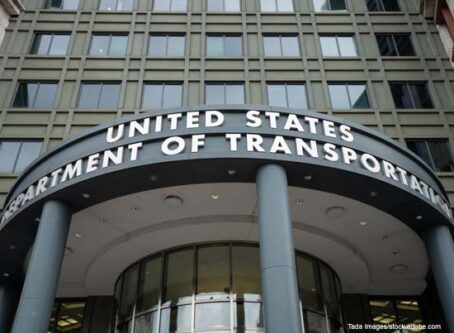Trucks and the U.S. Postal Service
Three years ago, the United States Postal Service announced it would cut back on air transport and put more mail on trucks. But in April and May, we saw some of those trucks in a long line waiting to enter a USPS facility 30 miles southwest of Atlanta in Palmetto, Ga.
The sprawling Atlanta Regional Processing & Distribution Center that opened in February was supposed to replace four smaller centers to increase overall efficiency. Instead, problems inside the facility caused a massive slowdown, a leadership crisis for the Postal Service, and that line of trucks long enough to draw the attention of national media.
The line at times was said to stretch half a mile and consisted almost entirely of truckload contractors whose drivers weren’t earning a cent while waiting anywhere from four to eight hours, according to some Atlanta-area media outlets.
We’ll come back to the reasons for the troubles at Palmetto, but the line of commercial 18-wheelers in its own way indicates how important private truckload carriers now are to the Postal Service.
For almost a century, from the mid-1800s to the mid-1900s, most mail in the U.S. moved on scheduled passenger trains in dedicated cars officially called Railway Post Offices or RPOs. In an RPO, postal clerks sorted mail as the train rolled. RPOs served even the smallest towns without the train having to stop. Postal clerks kicked inbound mail bags off the moving train while outbound mail bags were snatched by hook from a stand next to the tracks.
It was a remarkably efficient system, and in 1930 some 10,000 scheduled trains hauled mail all across the country, according to the Postal Service.
The RPOs went away largely due to the interstate highway system and the rise of air transportation. Together, they all but killed off rail passenger service that had also carried the mail. Flying post offices were not an option.
By 1965, “only 190 passenger trains carried mail, and by 1970, the railroads carried virtually no First-Class Mail,” according to the Postal Service website. Trucks and planes had become the Postal Service’s main modes of transportation. Some mail continues to move by rail, but now more slowly as freight, often in intermodal containers.
Meanwhile, the telephone and eventually the internet were shrinking the use of first-class mail, and the Postal Service was losing money – lots of money. Currently the Postal Service is more than $160 billion in debt by some estimates and expects to lose well north of $6 billion this year – pretty much as it did last year.
That’s what impelled the program called Delivering for America, which was announced in 2021 by controversial Postmaster General Louis DeJoy.
An important element of the program is a large shift of mail from airplanes to trucks.
The Postal Service itself runs approximately 235,000 vehicles, most of them for local delivery. They also operate approximately 9,000 tractor-trailers, but few move mail any more than 50 miles.
For longer runs USPS uses contractors through two programs. One is with the Highway Contract Route or HCR – the equivalent of a commercial truckload contract. The other is through what the Postal Service calls Freight Auction – the equivalent of the commercial spot market.
It should be no surprise that the greatest expansion of contracted truck transportation has been in the spot market where rates have been low. Between 2022, when the current freight recession began, and the end of 2023, the Postal Service’s use of the spot market – often through brokers – went from 43,533 annual trips to 187,573 – an increase of 350%.
According to the Postal Service’s Office of Inspector General, USPS covers 1.6 billion “surface mail transportation miles” every year. That’s roughly 4 million miles a day.
At the same time, the Postal Service cut loose many smaller contracting carriers, some of which had hauled mail for decades, in favor of larger carriers. According to USPS officials, the change consolidates operations and centralizes billing, saving money in the process.
Some small carriers that once served the Postal Service directly now must subcontract with a larger HCR carrier.
The rules for becoming a HCR postal carrier are murky at best. The Postal Service says HCR routes are put out for bid, but you can only bid if the Postal Service invites you to. To get an invitation you must fill out forms at the USPS Supplier Registration site providing information on the size and capabilities of your fleet.
While the site does not mention a minimum fleet size, it’s generally understood that larger carriers are more likely to be invited to bid.
Unfortunately, the Postal Service has done a poor job of overseeing the safety of its contractors and their subcontractors. In June of 2022 an uninsured mail subcontractor without a CDL plowed his 1999 Kenworth into the back of a car on I-25 in Colorado, killing six people, including five from one family.
In a highly critical report released earlier this year, the Postal Service’s Inspector General noted – among other lapses – the Postal Service “did not track contractor accidents and fatalities” and “did not always know who was authorized to transport the mail or enforce the terms and conditions of the contracts.”
According to the Inspector General’s report, the Postal Service has 4,600 trucking contracts worth $5.2 billion.
Noting the tragic crash and the Inspector General’s report, the U.S. House of Representatives recently passed a law requiring the Postal Service to tighten its oversight of contractors. The bill has gone to the Senate where it awaits action.
But trucking contractors aren’t the Postal Service’s only problem. That brings us back to the Atlanta Regional Processing & Distribution Center in Palmetto, Ga., where all those trucks waiting in line are the least of the Postal Service’s problems.
The logjam inside the Palmetto facility has caused a dangerous mail delivery slowdown in Georgia. Checks have not been arriving on time, nor have mail-order medications. The state’s Congressional delegation is hopping mad.
The Palmetto center is one of 60 new regional mail processing centers planned or already open, and it’s not the only one with troubles. Slow mail delivery has also been reported in Richmond, Va., and Houston, among other locations.
Perhaps as a result, last week DeJoy agreed to halt planned changes to the Postal Service’s network under the Delivering for America plan. The pause will last for the balance of 2024.
Meanwhile, even as it expands its use of commercial fleets, the Postal Service is seeking to bring more trucking in-house. Starting in Oklahoma City two years ago, the program involves the new job title of “postal vehicle operator” and has since expanded to Richmond. Whether the expansion of that program will be on hold for the rest of the year remains to be seen.
Meanwhile, tractor-trailer driving opportunities as a Postal Service employee, can be found here. LL









